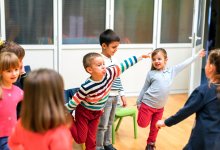Social & Emotional Learning (SEL)
Find resources to help students manage their emotions, resolve conflicts, and make responsible decisions—creating the healthiest school culture possible.
To Choose the Right SEL Program, Ask the Right Questions
CASEL has a free tool that can help school leaders sift through the many social and emotional learning programs to select a good fit for their school.How to Address School Avoidance
To help reduce chronic absenteeism, schools can help students learn how to self-regulate and manage feelings of discomfort.Your content has been saved!
Go to My Saved Content.Using Theater Games to Build Students’ Working Memory
By holding onto the information necessary to play certain games, students develop skills that lead to academic success.Your content has been saved!
Go to My Saved Content.Teaching Young Learners Self-Calming Skills
To help early elementary students manage big emotions, try breathing exercises and sharing how you deal with overpowering feelings.Your content has been saved!
Go to My Saved Content.Adding an Academic Focus to SEL in High School
Social, emotional, and academic development (SEAD) is a subtle shift from SEL, but it can make a big difference for students.297Your content has been saved!
Go to My Saved Content.Why Ages 2-7 Matter So Much for Brain Development
Rich experiences—from play to the arts and relationships—fundamentally shape a young child’s development.124kYour content has been saved!
Go to My Saved Content.19 Ways to Help Elementary Students Self-Regulate
These strategies can help young learners practice an essential life skill—and foster classroom harmony in the process.6 Research-Backed Ways to Break Up Your Lectures
Lectures are efficient ways to convey information, but kids tend to tune them out. Here are 6 activities that will keep students focused while improving learning outcomes.Making Students Feel Safe
A trauma-informed approach ensures that students feel safe, supported, and nurtured—to improve their chances of academic success.129.7kYour content has been saved!
Go to My Saved Content.De-escalating the Brain, Not the Behavior
When students feel intense emotions, it’s important for teachers to meet them where they are and use strategies that guide them toward self-regulation.Building Classroom Community Through Daily Dedications
When students share stories about those who have inspired and impacted them, the whole classroom feels more connected.47kYour content has been saved!
Go to My Saved Content.When Students Are Traumatized, Teachers Are Too
Trauma in students’ lives takes an emotional and physical toll on teachers as well. Experts weigh in on the best ways to cope.113.8kYour content has been saved!
Go to My Saved Content.How Learning Happens
In this series, we explore how educators can guide all students, regardless of their developmental starting points, to become productive and engaged learners.66kYour content has been saved!
Go to My Saved Content.8 Proactive Classroom Management Tips
New teachers—and experienced ones too—can find ideas here on how to stop disruptive behavior before it begins.78.5kYour content has been saved!
Go to My Saved Content.A Daily Support System for Students
Students who need extra social and emotional support have a quick check-in with an adult at the start and end of each day.89.9kYour content has been saved!
Go to My Saved Content.











